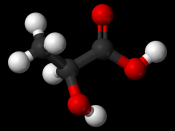Cells need to be able to transport very small molecules at quick rates. It is also often necessary to have consistent molecule concentration though out a cell. As a cell expands, volume becomes so great that passive means of transport such as osmosis become inadequate. Even active means, including ion "pumps" in the cell membrane, are not able to take molecules over long distances. Cells can overcome this problem, but only to a certain degree. A neuron, you may know, has a long extension known as an axon. Neurons have developed two different means of active transportation in order to bring molecules from the cell body to the ends of the axons. In cell culture most non-neoplastic cells only grow to a certain point due to a phenomenon known as contact inhibition. As cells come in contact with each other, growth stops due to the molecular cues generated. The same occurs in vivo.
Of course apart from spatial constraints, hormonal and at times migratory cues (as in the case of the developing neural system) also contribute, not only to cell size but also in sculpting the actual morphology of the cell. In vivo there are many more answers. In general, in non-germ line cells, it is thought that cells grow until they achieve a certain cell size and beyond this they begin to undergo mitosis. In spite of the great complexity of living organisms and the types of cells they contain, there are only two basic types of cell division: one type is called meiosis the other mitosis. For all intents and purposes, cells undergo mitosis when they are growing, i.e. when the purpose of cell division is to reproduce more cells within the same organism, e.g. more blood cells, more skin cells, more liver cells, more of anything, whether...


![Global Photosynthesis Visualized [video]](https://s.writework.com/uploads/5/59070/global-photosynthesis-visualized-video-thumb.jpg)